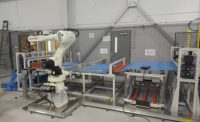Hydraulic valves direct the flow of a liquid medium, usually oil, through a hydraulic system. These valves are used in a variety of applications, including heavy trucks, farm equipment, and mining and construction machinery.
Market research firm IndustryARC estimates that global sales of hydraulic valves and control products will grow at a compound annual rate of 5.6 percent over the next seven years, exceeding $39.4 billion by 2024. In short, a lot of valves will need to get made in the next few years, and that can only be accomplished with automation.
Recently, systems integrator RND Automation designed and built a multistation automated assembly system to produce hydraulic valves. The machine is based on the company’s Modular Assembly Platform (MAP), a highly customizable standard platform that can be used for a variety of assembly and testing operations.
The platform is built around MagneMotion’s linear motor transfer technology. This system works on the principle of a “smart” track—consisting of multiple linear servomotors—and a “dumb” mover outfitted with powerful magnets. Coordinating the activation of electromagnetic coils in the motors propels the movers around the track. This arrangement provides multiple advantages for automated assembly, including high transfer speeds; precise control of acceleration and deceleration; accurate positioning; the ability to move product forward and backward on the line; and independent control over individual pallets.
“The MagneMotion system and frame design create a modular system and allow us to add bays as required,” explains Sean Dotson, president and CEO of RND Automation, which is based in Lakewood Ranch, FL. “While the valve assembly machine is only a single-bay system, we have built systems up to six bays long with 14 robots.”
The MAP is controlled by Allen Bradley PLCs and touchscreen HMIs. “Our intuitive interface allows you to recover from any fault in a matter of moments,” says Dotson. “The HMIs guide you through the recovery process and provide production data, such as overall equipment effectiveness, throughput and alarm history. Remote connection technology allows us to help diagnose any issues by giving our engineers online access to update code and HMI screens from our offices, regardless of where our machines may be deployed.”
Robots from Epson Robots are another key technology. Specifically, the system is equipped with a T3 All-in-One SCARA, a G3 SCARA and a C8 six-axis robot. RND chose the T3 for simple pick-and-place operations, due to its fast installation, low cost ($7,495) and built-in controller. The G3 is used for more demanding stations, because of its faster speed and ability to handle higher inertial loads. RND chose the C8 for its compact design and wide range of motion.
“Leveraging the Epson robots’ precision and fast cycle times, our assembly machine can produce one valve every 10 seconds, solving our customer’s need to ramp up volume and improve product quality,” says Dotson, whose company is a platinum-level Epson AutomateElite integrator. “Also, due to the cell’s compact design, our customer freed up a large amount of floor space.”
The system consists of eight stations. At the first station, a robot loads cans and locknuts into a carrier puck.
Next, a robot picks an adjustment screw from a feeder bowl and installs an O-ring onto it with a machine from Automated Industrial Systems. The robot then begins threading the screw into the can and locknut. The robot is equipped with a SCHUNK gripper and a Z-axis compliance device from ATI Industrial Automation to ensure the screw does not get cross-threaded.
At station 3, a pneumatic drive under the carrier puck drives the adjustment screw to the bottom as a lubricant is applied to the O-ring. Then, various springs are fed into the valve depending on the desired cracking pressure.
At station 5, a robot picks a hex body out of pallet that enters the system on a power-and-free conveyor from Glide-Line. The robot then installs a drop of thread-locking adhesive and starts the threading process (similar to station 2). The robot then removes the assembly and places it into a collet.
At station 6, a pneumatic torque driver completes assembly of the unit. Then, a robot removes the assembly from the collet and places it into a leak test fixture. The same robot removes the tested units and places them into empty pallets on the conveyor.
At station 8, full pallets of assembled valves exit the cell for further processing.
“With 20 years of experience in industrial machinery design, RND is well-equipped to provide customers with production-ready automated equipment that can help cut labor costs and improve quality and production rates,” says Gregg Brunnick, director of product management for Epson Robots. “The company’s team of experienced engineers and designers make sure to set customers up with custom equipment that is efficient, robust and reliable.”
“Epson offers excellent quality and technology at a competitive price,” adds Dotson. “The varied offerings allows us to choose the right robot for the application. Our experience with Epson has been that the robots continue to work with next to no intervention from the operator and maintenance staff.”
For more information on assembly systems, call RND Automation at 941-870-5400 or visit www.rndautomation.com. For more information on robots, call Epson at 562-290-5997 or visit www.epsonrobots.com.
To see the hydraulic valve assembly machine in action, visit https://youtu.be/IL30Uwfg-ds.



